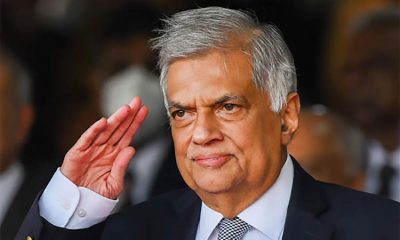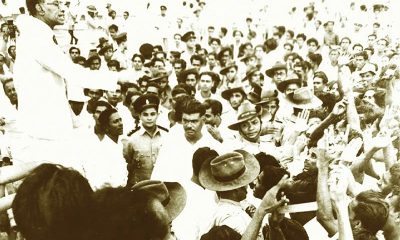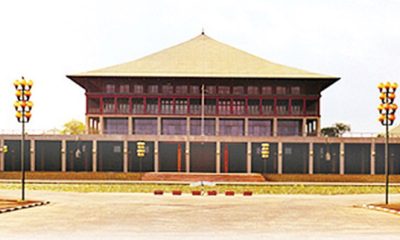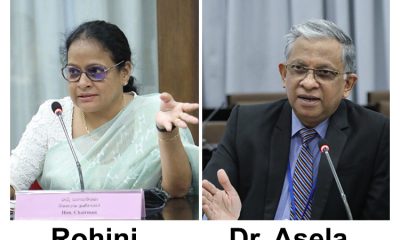Features
Good King Ranil and his options: Keep running or end the Executive Presidency
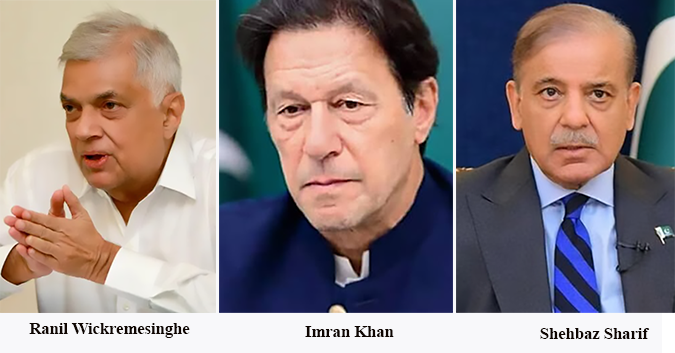
by Rajan Philips
PAKISTAN’S twisted political saga continues without the slightest deviation from a tired and predictable script. PTI chairman Imran Khan has been found guilty of “corrupt practices”, disqualified from representing the people of Pakistan, fined Rs100,000, and sentenced to three years in jail for good measure.
Dawn (Pakistan Daily), August 6 Editorial The only relevance to Sri Lanka in the citation above is how a “twisted political saga continues without the slightest deviation from a tired and predictable script.” Sri Lanka’s political saga is also twisted but in far less precarious and less intractable ways than in Pakistan. Put another way, Sri Lanka’s political saga is a muddling version of the more dangerous drama in Pakistan. And the muddling version, in my view, arises out of Ranil Wickremesinghe’s moves and maneuvers to be a candidate at the next presidential election. His obstinate objective is to become an elected president after quite fortuitously becoming a caretaker president. And why is that objectionable? Here is why.
After he was ousted from office in April 2022 through the chicanery of a no confidence motion in parliament, Imran Khan has been agitating for general elections to be held for the people to decide who should be running their government – elected representatives or ensconced army generals. After ignoring the election calls for over a year, the Shehbaz Sharif government has dissolved parliament (for new elections mandated to be held within 90 days) just three days after the Election Commission barred the former Prime Minister from running for office for the next five years. The five year disbarment is based on the ridiculous three year jail sentence that the lower courts have meted out to Imran Khan based on spurious charges of improper declaration of ceremonial gifts received from foreign dignitaries. So, Pakistan’s tragic political drama continues with the same old script and the same unhidden military hand, but with a different cast of actors.
Unlike in Pakistan, there is no military hand in Sri Lanka, hidden or not hidden, despite occasional speculations to the contrary. The stifling leviathan in Sri Lanka is the Executive Presidency, which over a period of 46 years has emaciated parliament and reduced a reasonably well-functioning administrative machinery to institutional dysfunctionality. There are two sides to Sri Lanka’s current crisis: A collapsed economy and a dysfunctional political and administrative system. It is the latter dysfunctionality that primarily caused the collapse of the economy. At least a partial reforming of the political and administrative systems is necessary if the economy is to be salvaged and put on a sustainable development path.
Reform Possibilities
My contention is that any and all possibilities of even a partial political reform are being destroyed by Ranil Wickremesinghe’s pre-occupation with becoming an elected president. Put another way, going ahead with the next presidential election, whenever it is due or prematurely called, and enabling Wickremesinghe to become an elected President will permanently entrench the current political deformities. That will also scupper all efforts toward saving the economy and growing it.
The situation will not be any different or the prospects for reform will not get any better even if Ranil Wickremesinghe were to be defeated in a presidential election and someone else were to become President. This will be so even if Anura Kumara Dissanayake were to become the next elected President of Sri Lanka. It is not because Mr. Dissanayake will not sincerely try to achieve political reform including the ending of the elected presidential system. It is because his efforts will be systemically frustrated. He will be frustrated by parliament; the majority of whose members will be hostile to any constitutional reform initiative that the JVP may sponsor. The hostility and sabotage will be there whether it is the current parliament or a future parliament with JVP having as many as forty times more MPs than it has today.
Historically, the very first election for a new President in 1982 featured a candidate who ran on the sole plank of dismantling the presidential system, restoring parliamentary government, and selflessly withdrawing from power. That was Colvin R de Silva, but his promises were resoundingly rejected, and he became ‘the prophet outcast’ at home, though not quite like in the circumstances of Leon Trotsky in post-revolutionary Russia.
In every presidential election from 1994 till 2015, the winning and losing candidates promised to abolish the presidential system but did nothing about it after the elections. The biggest betrayer was Maithripala Sirisena who won the election in 2015 as a common opposition candidate and unprecedentedly defeating an incumbent president. Sirisena’s co-conspirator was Ranil Wickremesinghe even though the two men were mutually estranged as political bedfellows.
By the quirkiest of quirks, Ranil Wickremesinghe is now President, but rather than building alliances and support for reforming the presidency, Mr. Wickremesinghe is creating cabals among his own government MPs to advance his presidential candidacy. In normal times, such maneuverings could have been seen as Machiavellian brilliance. These are not normal times, and such machinations are hardly becoming of a man of Mr. Wickremesinghe’s age and the caretaker circumstances in which he was vaulted to power. There are two matters of concern here.
First, Mr. Wickremesinghe, in his current capacity as caretaker president, is squandering a rare and fortuitous opportunity to initiate and implement serious political reforms including the reform of the presidency. The somewhat ‘hung’ situation of the current parliament without a dominant party or alliance is an ideal opportunity for coalescing sufficient numbers of like minded MPs to support a positive reform agenda. The numbers (and members) are there in parliament for President Wickremesinghe to facilitate a two-third majority, constitutional-reform voting bloc if only he would jettison his usual machination habits and work with honesty and sincerity on a principled reform agenda.
The agenda can be limited to a few critical areas of reform: the presidency, the electoral system, provincial councils, and public service. Enough work has been done in each of these area for decades and there are enough people who could draft up the details of reform for the President and for parliament. If a referendum is needed it could be piggybacked on to a nationwide election – either local government, provincial council or parliamentary elections. Fundamentally, there should be no more presidential elections and the election of future Heads of State, after the current President, should not be directly by the people but through their representatives in parliament ,and potentially in the provincial councils.
There will have to be a sunset arrangement for President Wickremesinghe as part of such a reform agenda. If he were to play a crucial role, in good faith, in facilitating the reform process, there could be consensus among political parties to extend his time in office, but with reduced powers, under the new system of indirect election by the people’s representatives rather than directly by the people. An extended term in office for the caretaker president would also enable him to focus primarily on the economic crisis and to continue in his current role as the country’s economic ambassador and plenipotentiary. This is wishful thinking, but better than the baleful schemes that the President seems to be currently pursuing. The latter is the second matter of concern.
Ominous Ranil
There is an ominous side to Ranil Wickremesinghe. He has not been shy of exposing it after succeeding the runaway Gotabaya as caretaker president. At that time last year, Imran Khan was out of office in Pakistan and was leading countrywide agitations for a general election. He reportedly rejected the idea of emulating the aragalaya agitation that successfully brought down a Prime Minister and President in a matter of weeks and months. Perhaps, he made the right judgement call in the context of Pakistan, where confrontation with the military may have led to a nationwide bloodbath. Today, Imran Khan languishes in jail and is barred from contesting the upcoming general election.
In contrast, Ranil Wickremesinghe, who cannot ever lead a political protest, became the biggest beneficiary of Sri Lanka’s most consequential protest. He is now President and wants to hold no other election other than a presidential election as it is the only election that he (and his followers) can conceivably win. Rather than reforming the presidency, Mr. Wickremesinghe is acting to perpetuate it. Imran Khan rejected emulating the Sri Lankan aragalaya in Pakistan, but there is much in common between the political machinations of the Shehbaz Sharif government in Pakistan and the Wickremesinghe administration in Sri Lanka.
As part of his agitation for national elections, Imran Khan got the provincial governments led by his party (PTI) in Punjab and Khyber Pakhtunkhwa to dissolve their assemblies to force elections. But the Sharif government let the dissolved assemblies remain in limbo, ignoring the constitutional mandate for holding elections within 90 days of dissolution. The government rebuked the judiciary for ordering an election date, and made its own ruling that elections could not be held due to the prevailing economic crisis and security situation. Sounds familiar?
As soon as Imran Khan was illegitimately barred from contesting, it was time for dissolving parliament in Pakistan, economic crisis or not. Similarly in Sri Lanka, the treasury has no cash for conducting local elections, but it will find plenty of cash for a presidential election if and when Ranil Wickremesinghe decides to have one at the convenient time of his choosing. Should he be allowed to do so? And thereby not merely prolong but perpetuate a dysfunctional political system? Alternatively, could a reform project be launched, and the current caretaker presidency be brought to a desirable end? The country has options too.
Features
Rethinking post-disaster urban planning: Lessons from Peradeniya
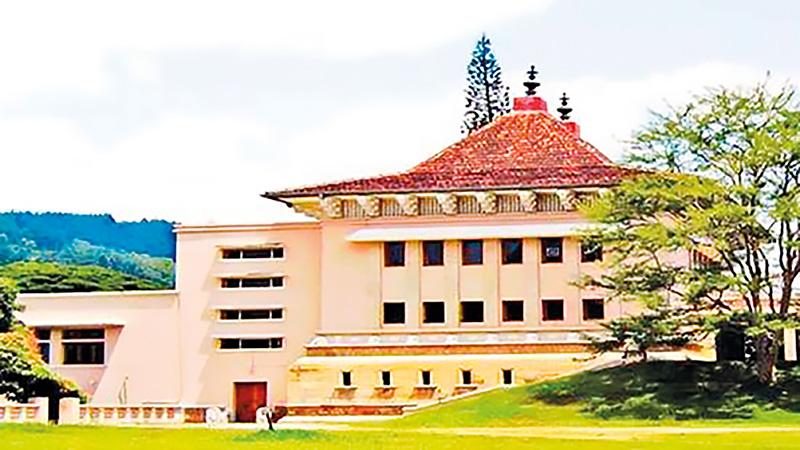
A recent discussion by former Environment Minister, Eng. Patali Champika Ranawaka on the Derana 360 programme has reignited an important national conversation on how Sri Lanka plans, builds and rebuilds in the face of recurring disasters.
His observations, delivered with characteristic clarity and logic, went beyond the immediate causes of recent calamities and focused sharply on long-term solutions—particularly the urgent need for smarter land use and vertical housing development.
Ranawaka’s proposal to introduce multistoried housing schemes in the Gannoruwa area, as a way of reducing pressure on environmentally sensitive and disaster-prone zones, resonated strongly with urban planners and environmentalists alike.
It also echoed ideas that have been quietly discussed within academic and conservation circles for years but rarely translated into policy.
One such voice is that of Professor Siril Wijesundara, Research Professor at the National Institute of Fundamental Studies (NIFS) and former Director General of the Royal Botanic Gardens, Peradeniya, who believes that disasters are often “less acts of nature and more outcomes of poor planning.”
“What we repeatedly see in Sri Lanka is not merely natural disasters, but planning failures,” Professor Wijesundara told The Island.
“Floods, landslides and environmental degradation are intensified because we continue to build horizontally, encroaching on wetlands, forest margins and river reservations, instead of thinking vertically and strategically.”
The former Director General notes that the University of Peradeniya itself offers a compelling case study of both the problem and the solution. The main campus, already densely built and ecologically sensitive, continues to absorb new faculties, hostels and administrative buildings, placing immense pressure on green spaces and drainage systems.
“The Peradeniya campus was designed with landscape harmony in mind,” he said. “But over time, ad-hoc construction has compromised that vision. If development continues in the same manner, the campus will lose not only its aesthetic value but also its ecological resilience.”
Professor Wijesundara supports the idea of reorganising the Rajawatte area—located away from the congested core of the university—as a future development zone. Rather than expanding inward and fragmenting remaining open spaces, he argues that Rajawatte can be planned as a well-designed extension, integrating academic, residential and service infrastructure in a controlled manner.
Crucially, he stresses that such reorganisation must go hand in hand with social responsibility, particularly towards minor staff currently living in the Rajawatte area.
“These workers are the backbone of the university. Any development plan must ensure their dignity and wellbeing,” he said. “Providing them with modern, safe and affordable multistoried housing—especially near the railway line close to the old USO premises—would be both humane and practical.”
According to Professor Wijesundara, housing complexes built near existing transport corridors would reduce daily commuting stress, minimise traffic within the campus, and free up valuable land for planned academic use.
More importantly, vertical housing would significantly reduce the university’s physical footprint.
Drawing parallels with Ranawaka’s Gannoruwa proposal, he emphasised that vertical development is no longer optional for Sri Lanka.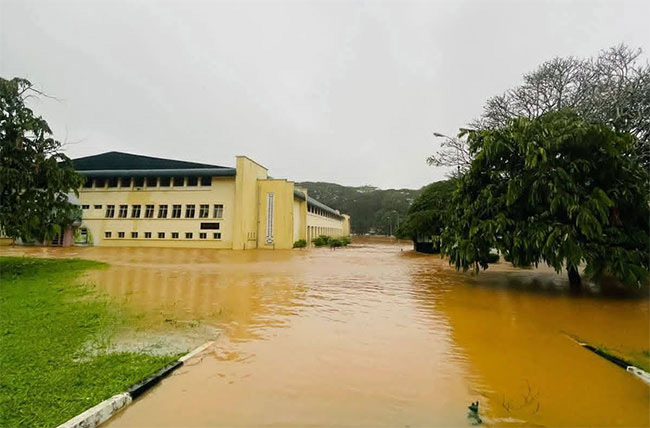
“We are a small island with a growing population and shrinking safe land,” he warned.
“If we continue to spread out instead of building up, disasters will become more frequent and more deadly. Vertical housing, when done properly, is environmentally sound, economically efficient and socially just.”
The veteran botanist also highlighted the often-ignored link between disaster vulnerability and the destruction of green buffers.
“Every time we clear a lowland, a wetland or a forest patch for construction, we remove nature’s shock absorbers,” he said.
“The Royal Botanic Gardens has survived floods for over a century precisely because surrounding landscapes once absorbed excess water. Urban planning must learn from such ecological wisdom.”
Professor Wijesundara believes that universities, as centres of knowledge, should lead by example.
“If an institution like Peradeniya cannot demonstrate sustainable planning, how can we expect cities to do so?” he asked. “This is an opportunity to show that development and conservation are not enemies, but partners.”
As climate-induced disasters intensify across the country, voices like his—and proposals such as those articulated by Patali Champika Ranawaka—underscore a simple but urgent truth: Sri Lanka’s future safety depends not only on disaster response, but on how and where we build today.
The challenge now lies with policymakers and planners to move beyond television studio discussions and academic warnings, and translate these ideas into concrete, people-centred action.
By Ifham Nizam ✍️
Features
Superstition – Major barrier to learning and social advancement

At the initial stage of my six-year involvement in uplifting society through skill-based initiatives, particularly by promoting handicraft work and teaching students to think creatively and independently, my efforts were partially jeopardized by deep-rooted superstition and resistance to rational learning.
Superstitions exerted a deeply adverse impact by encouraging unquestioned belief, fear, and blind conformity instead of reasoning and evidence-based understanding. In society, superstition often sustains harmful practices, social discrimination, exploitation by self-styled godmen, and resistance to scientific or social reforms, thereby weakening rational decision-making and slowing progress. When such beliefs penetrate the educational environment, students gradually lose the habit of asking “why” and “how,” accepting explanations based on fate, omens, or divine intervention rather than observation and logic.
Initially, learners became hesitant to challenge me despite my wrong interpretation of any law, less capable of evaluating information critically, and more vulnerable to misinformation and pseudoscience. As a result, genuine efforts towards social upliftment were obstructed, and the transformative power of education, which could empower individuals economically and intellectually, was weakened by fear-driven beliefs that stood in direct opposition to progress and rational thought. In many communities, illnesses are still attributed to evil spirits or curses rather than treated as medical conditions. I have witnessed educated people postponing important decisions, marriages, journeys, even hospital admissions, because an astrologer predicted an “inauspicious” time, showing how fear governs rational minds.
While teaching students science and mathematics, I have clearly observed how superstition acts as a hidden barrier to learning, critical thinking, and intellectual confidence. Many students come to the classroom already conditioned to believe that success or failure depends on luck, planetary positions, or divine favour rather than effort, practice, and understanding, which directly contradicts the scientific spirit. I have seen students hesitate to perform experiments or solve numerical problems on certain “inauspicious” days.
In mathematics, some students label themselves as “weak by birth”, which creates fear and anxiety even before attempting a problem, turning a subject of logic into a source of emotional stress. In science classes, explanations based on natural laws sometimes clash with supernatural beliefs, and students struggle to accept evidence because it challenges what they were taught at home or in society. This conflict confuses young minds and prevents them from fully trusting experimentation, data, and proof.
Worse still, superstition nurtures dependency; students wait for miracles instead of practising problem-solving, revision, and conceptual clarity. Over time, this mindset damages curiosity, reduces confidence, and limits innovation, making science and mathematics appear difficult, frightening, or irrelevant. Many science teachers themselves do not sufficiently emphasise the need to question or ignore such irrational beliefs and often remain limited to textbook facts and exam-oriented learning, leaving little space to challenge superstition directly. When teachers avoid discussing superstition, they unintentionally reinforce the idea that scientific reasoning and superstitious beliefs can coexist.
To overcome superstition and effectively impose critical thinking among students, I have inculcated the process to create a classroom culture where questioning was encouraged and fear of being “wrong” was removed. Students were taught how to think, not what to think, by consistently using the scientific method—observation, hypothesis, experimentation, evidence, and conclusion—in both science and mathematics lessons. I have deliberately challenged superstitious beliefs through simple demonstrations and hands-on experiments that allow students to see cause-and-effect relationships for themselves, helping them replace belief with proof.
Many so-called “tantrik shows” that appear supernatural can be clearly explained and exposed through basic scientific principles, making them powerful tools to fight superstition among students. For example, acts where a tantrik places a hand or tongue briefly in fire without injury rely on short contact time, moisture on the skin, or low heat transfer from alcohol-based flames rather than divine power.
“Miracles” like ash or oil repeatedly appearing from hands or idols involve concealment or simple physical and chemical tricks. When these tricks are demonstrated openly in classrooms or science programmes and followed by clear scientific explanations, students quickly realise how easily perception can be deceived and why evidence, experimentation, and critical questioning are far more reliable than blind belief.
Linking concepts to daily life, such as explaining probability to counter ideas of luck, or biology to explain illness instead of supernatural causes, makes rational explanations relatable and convincing.
Another unique example that I faced in my life is presented here. About 10 years ago, when I entered my new house but did not organise traditional rituals that many consider essential for peace and prosperity as my relatives believed that without them prosperity would be blocked. Later on, I could not utilise the entire space of my newly purchased house for earning money, largely because I chose not to perform certain rituals.
While this decision may have limited my financial gains to some extent, I do not consider it a failure in the true sense. I feel deeply satisfied that my son and daughter have received proper education and are now well settled in their employment, which, to me, is a far greater achievement than any ritual-driven expectation of wealth. My belief has always been that a house should not merely be a source of income or superstition-bound anxiety, but a space with social purpose.
Instead of rituals, I strongly feel that the unused portion of my house should be devoted to running tutorials for poor and underprivileged students, where knowledge, critical thinking, and self-reliance can be nurtured. This conviction gives me inner peace and reinforces my faith that education and service to society are more meaningful measures of success than material profit alone.
Though I have succeeded to some extent, this success has not been complete due to the persistent influence of superstition.
by Dr Debapriya Mukherjee
Former Senior Scientist
Central Pollution Control Board, India ✍️
Features
Race hate and the need to re-visit the ‘Clash of Civilizations’

 Australian Prime Minister Anthony Albanese has done very well to speak-up against and outlaw race hate in the immediate aftermath of the recent cold-blooded gunning down of several civilians on Australia’s Bondi Beach. The perpetrators of the violence are believed to be ardent practitioners of religious and race hate and it is commendable that the Australian authorities have lost no time in clearly and unambiguously stating their opposition to the dastardly crimes in question.
Australian Prime Minister Anthony Albanese has done very well to speak-up against and outlaw race hate in the immediate aftermath of the recent cold-blooded gunning down of several civilians on Australia’s Bondi Beach. The perpetrators of the violence are believed to be ardent practitioners of religious and race hate and it is commendable that the Australian authorities have lost no time in clearly and unambiguously stating their opposition to the dastardly crimes in question.
The Australian Prime Minister is on record as stating in this connection: ‘ New laws will target those who spread hate, division and radicalization. The Home Affairs Minister will also be given new powers to cancel or refuse visas for those who spread hate and a new taskforce will be set up to ensure the education system prevents, tackles and properly responds to antisemitism.’
It is this promptness and single-mindedness to defeat race hate and other forms of identity-based animosities that are expected of democratic governments in particular world wide. For example, is Sri Lanka’s NPP government willing to follow the Australian example? To put the record straight, no past governments of Sri Lanka initiated concrete measures to stamp out the evil of race hate as well but the present Sri Lankan government which has pledged to end ethnic animosities needs to think and act vastly differently. Democratic and progressive opinion in Sri Lanka is waiting expectantly for the NPP government’ s positive response; ideally based on the Australian precedent to end race hate.
Meanwhile, it is apt to remember that inasmuch as those forces of terrorism that target white communities world wide need to be put down their counterpart forces among extremist whites need to be defeated as well. There could be no double standards on this divisive question of quashing race and religious hate, among democratic governments.
The question is invariably bound up with the matter of expeditiously and swiftly advancing democratic development in divided societies. To the extent to which a body politic is genuinely democratized, to the same degree would identity based animosities be effectively managed and even resolved once and for all. To the extent to which a society is deprived of democratic governance, correctly understood, to the same extent would it experience unmanageable identity-bred violence.
This has been Sri Lanka’s situation and generally it could be stated that it is to the degree to which Sri Lankan citizens are genuinely constitutionally empowered that the issue of race hate in their midst would prove manageable. Accordingly, democratic development is the pressing need.
While the dramatic blood-letting on Bondi Beach ought to have driven home to observers and commentators of world politics that the international community is yet to make any concrete progress in the direction of laying the basis for an end to identity-based extremism, the event should also impress on all concerned quarters that continued failure to address the matters at hand could prove fatal. The fact of the matter is that identity-based extremism is very much alive and well and that it could strike devastatingly at a time and place of its choosing.
It is yet premature for the commentator to agree with US political scientist Samuel P. Huntingdon that a ‘Clash of Civilizations’ is upon the world but events such as the Bondi Beach terror and the continuing abduction of scores of school girls by IS-related outfits, for instance, in Northern Africa are concrete evidence of the continuing pervasive presence of identity-based extremism in the global South.
As a matter of great interest it needs mentioning that the crumbling of the Cold War in the West in the early nineties of the last century and the explosive emergence of identity-based violence world wide around that time essentially impelled Huntingdon to propound the hypothesis that the world was seeing the emergence of a ‘Clash of Civilizations’. Basically, the latter phrase implied that the Cold War was replaced by a West versus militant religious fundamentalism division or polarity world wide. Instead of the USSR and its satellites, the West, led by the US, had to now do battle with religion and race-based militant extremism, particularly ‘Islamic fundamentalist violence’ .
Things, of course, came to a head in this regard when the 9/11 calamity centred in New York occurred. The event seemed to be startling proof that the world was indeed faced with a ‘Clash of Civilizations’ that was not easily resolvable. It was a case of ‘Islamic militant fundamentalism’ facing the great bulwark, so to speak, of ‘ Western Civilization’ epitomized by the US and leaving it almost helpless.
However, it was too early to write off the US’ capability to respond, although it did not do so by the best means. Instead, it replied with military interventions, for example, in Iraq and Afghanistan, which moves have only earned for the religious fundamentalists more and more recruits.
Yet, it is too early to speak in terms of a ‘Clash of Civilizations’. Such a phenomenon could be spoken of if only the entirety of the Islamic world took up arms against the West. Clearly, this is not so because the majority of the adherents of Islam are peaceably inclined and want to coexist harmoniously with the rest of the world.
However, it is not too late for the US to stop religious fundamentalism in its tracks. It, for instance, could implement concrete measures to end the blood-letting in the Middle East. Of the first importance is to end the suffering of the Palestinians by keeping a tight leash on the Israeli Right and by making good its boast of rebuilding the Gaza swiftly.
Besides, the US needs to make it a priority aim to foster democratic development worldwide in collaboration with the rest of the West. Military expenditure and the arms race should be considered of secondary importance and the process of distributing development assistance in the South brought to the forefront of its global development agenda, if there is one.
If the fire-breathing religious demagogue’s influence is to be blunted worldwide, then, it is development, understood to mean equitable growth, that needs to be fostered and consolidated by the democratic world. In other words, the priority ought to be the empowerment of individuals and communities. Nothing short of the latter measures would help in ushering a more peaceful world.
-

 News3 days ago
News3 days agoMembers of Lankan Community in Washington D.C. donates to ‘Rebuilding Sri Lanka’ Flood Relief Fund
-

 Latest News6 days ago
Latest News6 days agoLandslide early warnings issued to the districts of Badulla, Kandy, Kurunegala, Matale and Nuwara-Eliya extended till 8AM on Sunday (21)
-

 News4 days ago
News4 days agoAir quality deteriorating in Sri Lanka
-

 Business5 days ago
Business5 days agoBrowns Investments sells luxury Maldivian resort for USD 57.5 mn.
-

 Editorial6 days ago
Editorial6 days agoCops as whipping boys?
-

 News4 days ago
News4 days agoCardinal urges govt. not to weaken key socio-cultural institutions
-
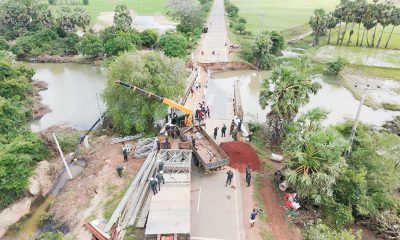
 Features5 days ago
Features5 days agoAnother Christmas, Another Disaster, Another Recovery Mountain to Climb
-

 Features5 days ago
Features5 days agoHatton Plantations and WNPS PLANT Launch 24 km Riparian Forest Corridor


